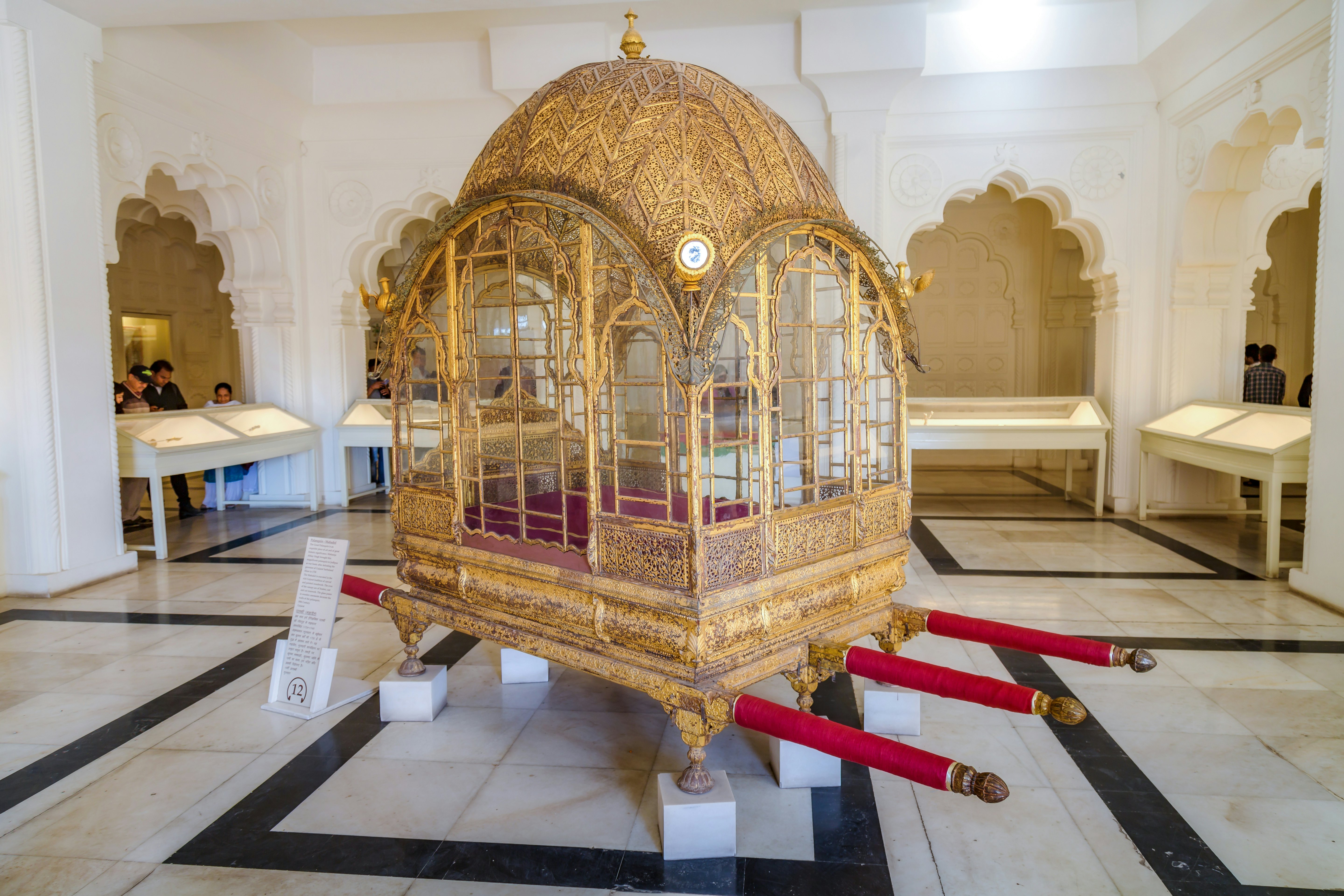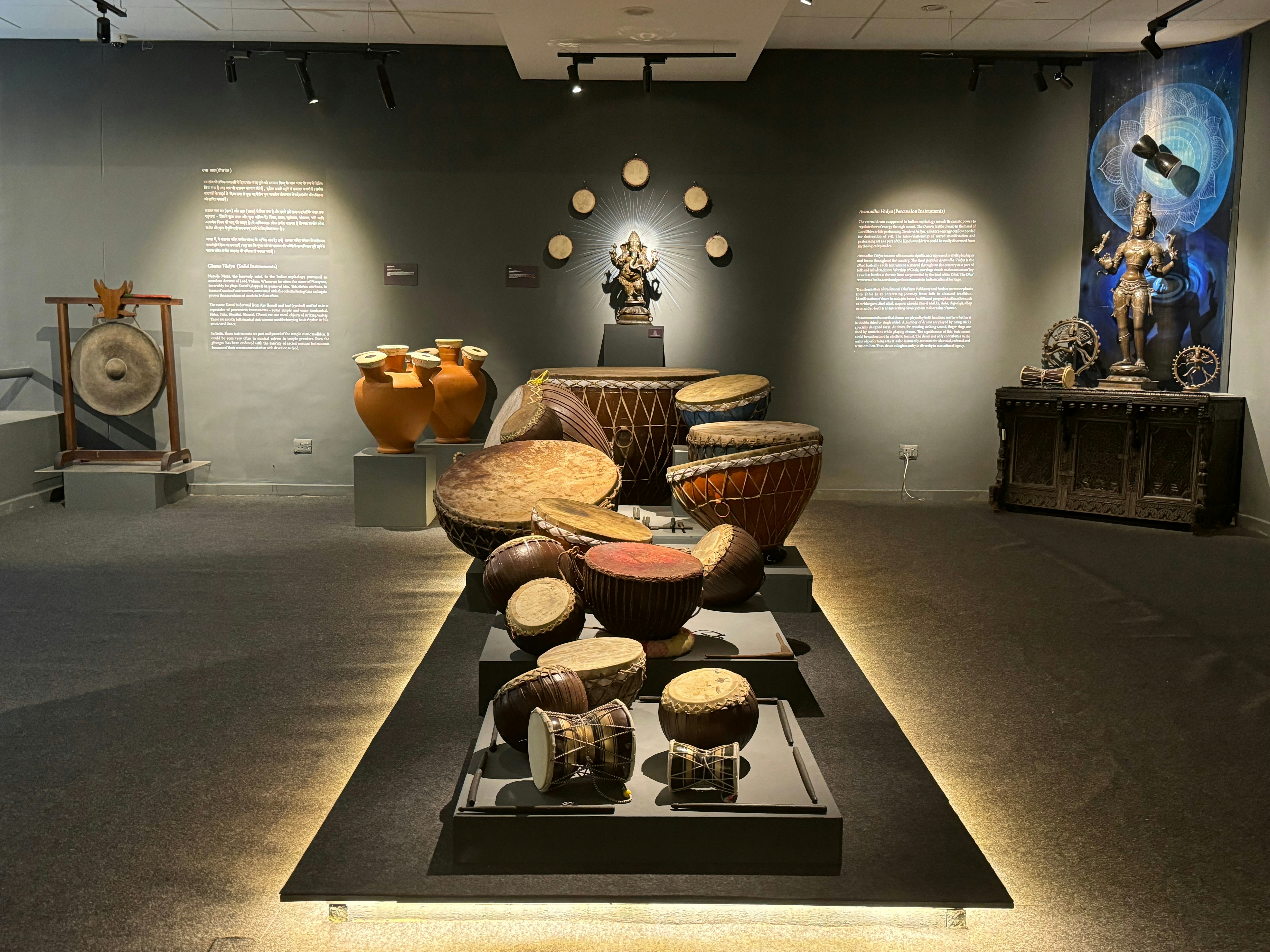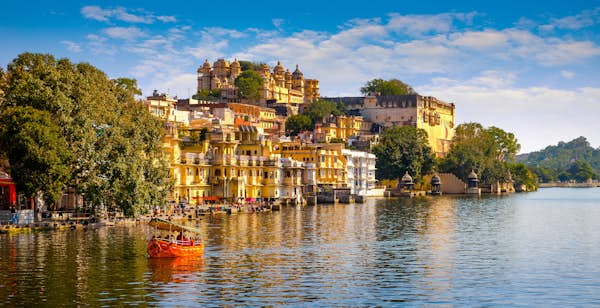The world’s most populous nation, India is not one country but myriad countries, forged by feuds and alliances between empires, dynasties and faiths over millennia, and bound together under one national flag. Understanding India’s national story becomes a lot easier once you visit its excellent museums – one of the top things to do as you explore this continent-sized country.
India’s museums are defined by vast collections of incredible objects – paintings, stone and wood carvings, jewelry, elaborate bronze statues, traditional costumes, musical instruments, ceramics, arms and armor and much, much more – that stand testament to the incredible skill and creativity of the people of the subcontinent.
Many Indian museums are housed in former royal palaces or elegant premises built during the late 19th and early 20th centuries to show off the country’s lavish culture and history to the masses. Across India, forts, temples and monasteries have their own collections of treasures and there are some wonderfully eccentric local museums dotted around the country.
Labeling can sometimes be hit or miss, but most museums have signage in English, Hindi and local languages for their most important exhibits. Expect large school groups on weekdays and lots of visitors at weekends – come right after museums open on weekday mornings for a quieter experience. Note that many museums are closed on Mondays and during religious and public holidays.
To kick-start your historical and cultural journey of discovery, here are the top museums in India.
Advertisement

1. National Museum, Delhi
Best for an overview of Indian history
The ancient treasures in India’s vast National Museum in Delhi are set to move from the museum’s current premises on Janpath into the Yuge Yugeen Bharat – a vast, under-construction museum that is destined to be the world’s largest, set inside the North Secretariat and South Secretariat buildings flanking Kartavya Path – in 2025.
For now, the dusty original building of the National Museum continues to house wonders such as mind-bogglingly ancient, sophisticated figurines from the 5000-year-old Harappan civilisation. There are also some fine ceramics from the even-older Nal civilization, and artifacts spanning most of India’s great empires, dynasties and religions.
Highlights include early Buddhist artifacts, exquisite jewellery, delicate miniature paintings from the major Indian painting schools, medieval woodcarvings, textiles and exquisitely decorated musical instruments. Look out for the immense, five-tiered wooden temple chariot built in South India in the 19th century.
There’s a lot to see, so take your time – expect to fill a whole morning or afternoon. This is one of India’s more accessible museums, with ramps for wheelchair users. The Anubhav Tactile Gallery has 22 touchable objects designed for people with visual impairment.
Planning tip: Close by in New Delhi, you can visit a string of residences linked to leading Indian political figures. Prioritize the Nehru Memorial Museum, devoted to the life and work of India’s first prime minister, the Indira Gandhi Memorial Museum, where the controversial leader lived and was assassinated, and Gandhi Smriti, where the Independence leader was assassinated after campaigning against intercommunal violence.
2. Salar Jung Museum, Hyderabad, Telangana
Best for glittering jewels and treasures
Topping the roster of museums in Hyderabad – once the capital of India’s richest princely state – is the vast Salar Jung Museum in the old city, displaying a collection amassed by Mir Yousuf Ali Khan (Salar Jung III), grand vizier to the seventh Nizam.
During his tenure, the trinket-loving courtier accumulated enough royal heirlooms to fill 39 galleries, covering everything from jade mouthpieces for hookah pipes and engraved talwar swords to European sculptures and exquisite paintings from all the Indian miniature schools.
The museum layout is rather confusing and it’s easy to miss whole sections of the collection, so take your time and look out for quirky pieces like the elegantly carved Veiled Rebecca by 19th-century Italian sculptor Benzoni, and the side rooms with extravagant Persian carpets and Chinese and Japanese celadon, porcelain and lacquerware.
Detour: You can see more of the treasures of the Nizams and their courtiers in the delightful, European-influenced Chowmahalla Palace, a short walk away from the Salar Jung Museum through the old city’s atmospheric bazaars, on the far side of the Charminar. Also make time to visit the sometimes overlooked Nizam’s Museum, containing the vast walk-through wardrobe of the sixth Nizam, and the rambling State Museum, constructed by the seventh Nizam as a playhouse for his daughter.

3. Chhatrapati Shivaji Maharaj Vastu Sangrahalaya, Mumbai
Best for fans of history and architecture
If you only have time to visit one museum in India, give serious consideration to the sprawling Chhatrapati Shivaji Maharaj Vastu Sangrahalaya, Mumbai’s largest museum. Visitors marvel over the expansive collection, covering everything from deity sculptures and weaponry to miniature paintings and tiny snuff bottles, and the building itself, a magnificent fusion of Hindu, Mughal and European architectural styles.
The museum has recently started hosting international touring exhibitions, such as 2024’s “Ancient Sculptures” show, which brought Greek and Roman artifacts to India for the first time, demonstrating links between India and Europe that go back millennia.
Advertisement
Planning tip: Around the corner from the city’s fabulous history museum, you can view some of Mumbai’s best art at the Jehangir Art Gallery and the nearby National Gallery of Modern Art. An auto-rickshaw, taxi or commuter train ride away, the Dr Bhau Daji Lad Mumbai City Museum is another treasure house of important artifacts in a charming, purpose-built building from 1872.
4. Indian Museum, Kolkata
Best for variety
A mind-boggling legacy of Indian architecture and artistry is on display at Kolkata’s Indian Museum, one of the country’s premier museums. Opened in 1814, the museum’s broad collection includes Egyptian mummies, a woolly mammoth skeleton and artifacts recovered from the Indus Valley settlement of Mohenjo-daro, one of the world’s first major cities.
The museum is housed in a striking Raj-era building near the Maidan, and it’s known locally as Jadu Ghar (The House of Magic). Alongside a powerhouse collection of religious art and sculpture, the Mughal miniatures in the Painting Gallery are the highlight of the museum’s art holdings.
Planning tip: Two other must-see museums in the city are the eccentric Marble Palace, packed with sculptures of Greek gods, grand pianos, billiards tables, Belgian glass and Chinese Ming vases, and the Victoria Memorial – worth a visit as much for the building and its gardens as for the displays on India’s Wars of Independence and relics from the Raj.

5. Mehrangarh, Jodhpur, Rajasthan
Best for royal treasures
A statement of royal power executed in stone, the mighty walls of the Mehrangarh fortress loom over the old city of Jodhpur, growing almost organically from the rocky cliffs. In 1459, Rao Jodha of the Rathore clan moved the Marwar capital to Jodhpur, and half a millennium later, the Rathore family still owns this enormous stronghold, preserved as one of Rajasthan’s best royal museums.
As you pass through the fort gates, fabulously ornate balconies gaze out from the upper levels, while the lower walls are windowless and impenetrable. You’ll pass a tragic collection of hand prints in the gatehouse, marking the suicide of royal wives on their husbands’ funeral pyres – the most recent from 1843.
A teardrop-shaped spiral staircase leads up to the 18th-century Sheesh Mahal, with displays of embroidered tents used for royal events and a lavish, deity-dotted mirrored hall. One level up, the Phool Mahal (Palace of Flowers) lives up to its name, with an astonishing gilded ceiling, floral panels dotted with vignette portraits of maharajas and insets depicting the “moods” of Indian classical music.
Next, you’ll reach the royal armoury, bristling with swords, spears, clubs, maces, knives, guns and other fearsome weapons. Look out for the swords and knives with hidden pistols. Other highlights include the ornate Takhat Vilas, the bedchamber of Maharaja Takhat Singh (r 1843–73), and the architecturally refined Moti Mahal (Pearl Palace) – a dignified space illuminated by panels set with gorgeously colourful glass.
Planning tip: You could easily do all the souvenir shopping for your whole trip in the Mehrangarh’s treasure trove of a gift shop. Shelves are piled high with everything from top-grade miniature paintings to showy outfits inspired by the wardrobes of the royal family.
6. City Palace, Udaipur, Rajasthan
Best for royal extravagance
Rajasthan gets a second spot on the list thanks to the magnificent City Palace in Udaipur. A wondrous collection of bulging balconies and turrets, towering over Lake Pichola, this extravagant 16th-century residence is Rajasthan’s largest palace and the seat of the Mewar maharanas, taking up half a kilometre of the lakeshore. Inside, the treasures of the Mewar rulers are truly something to behold.
The City Palace Museum fills much of the palace, centred on the Rai Angan (Royal Courtyard), where Maharana Udai Singh II met the sage who told him to build the city of Udaipur. Bear right as you enter to reach the astonishing armoury, full of whistle-tooting guards trying desperately to keep the crowds in order. Beyond is the often overlooked Government Museum, entered on a separate ticket.
The highlight of the palace proper is the collection of apartments once reserved for the royal household. Of particular note are the Baadi Mahal from 1699, ringed by open pavilions containing fountains and colourful stained glass, and the Kishan Vilas, with miniature paintings from the time of Maharana Bhim Singh (r 1778–1828). Executed in a Mewar-meets-baroque style, the turquoise Bhim Vilas is one of the most beautiful spaces in all of Rajasthan.
Planning tip: For a glimpse of Mewar extravagance, visit the Crystal Gallery in the palace compound (a separate entry fee applies), displaying an extraordinary collection of crystal-handled cutlery, plates and glasses, chandeliers and even a crystal bed. Maharana Sajjan Singh placed a massive order with English crystal maker F&C Osler & Co in 1877, but he died before it arrived, so the delivery was packed away, unopened, for 110 years.

7. Government Museum, Chennai, Tamil Nadu
Best for bronzes and metalwork
Spread across 6.5 hectares (16 acres), Chennai’s Government Museum is a precious repository of South Indian history and art. This cultural powerhouse, one of the oldest museums in India, allows you to traverse the corridors of time through an eclectic collection spanning art, archaeology and anthropology.
The museum’s main draw is the Bronze Gallery, which houses an extensive collection of South Indian bronzes from the 7th century CE to contemporary times. Highlights include bronze sculptures from the Chola period, which reached its peak between the 9th and 11th centuries; look out for striking representations of Shiva as Nataraja, the cosmic dancer.
The main Archaeological Galleries will take you on a journey through South Indian history with ancient artifacts from as early as the 2nd-century BCE, and fine 16th-century art encompassing Hindu, Buddhist and Jain traditions from the Vijayanagar kingdom, centered on Hampi in Karnataka. The Anthropology Galleries feature exhibits that trace the history of people in South India from prehistoric times, with Indigenous relics from across the state.
Planning tip: The Government Museum is closed on Fridays; show up right when it opens at 9:30am to avoid crowds of school children on field trips. Be sure to duck into the attached National Art Gallery and Contemporary Art Gallery, with an extensive collection of Tanjore and Raja Ravi Varma paintings.
8. Calico Museum of Textiles, Ahmedabad, Gujarat
Best for vivid colors
The collection of antique and modern textiles at Ahmedabad’s Calico Museum of Textiles is said to be second only to London’s Victoria & Albert Museum in breadth, scope and importance. Two-hour tours are offered Tuesday to Sunday (at 10:30am and 2:30pm) to only 20 people at a time, so booking ahead is essential, but the magnificent fabrics on display are worth competing for.
You’ll be awestruck by the beautiful handmade tapestries, royal garments, exquisite saris, tribal outfits, Patola and Mashru weaving and Bandhani tie-dye textiles, some of which are 500 years old. The tour guides’ explanations can sometimes be hard to follow, and there are no supplemental descriptions, but it hardly matters – the extraordinary textiles speak for themselves.
Planning tip: Next door, the new Arvind-Indigo Museum is a minimalist but deeply moving multi-room gallery dedicated to artistic manifestations of the colour indigo. It’s part of the larger Kasturbhai Lalbhai Museum, housed in the former bungalow of the founder of India’s largest denim company, displaying everything from Bihari and Rajasthani school paintings to hand-painted postcards from pre-independence India.

9. National Crafts Museum, Delhi
Best for discovering folk culture
The culture and customs of India’s diverse communities are best explored in dozens of regional folk museums dotted around the country. You’ll find collections exploring culture, folk art, community traditions and the lifestyles of India’s Adivasi (Indigenous) peoples in many major cities, from Kochi’s Kerala Folklore Museum to Bhubaneswar’s Odisha State Tribal Museum, but Delhi’s National Crafts Museum is particularly charming.
Much of this lovely folk art museum, located near the Purana Qila fort, is in the open air, including tree-shaded carvings and life-size examples of village huts from various regions of India. Displays celebrate traditional crafts, with a 30,000-strong collection of artifacts, including beautiful textiles, ceramics and a finely carved wooden temple chariot, and artisans make and sell traditional crafts in the rear courtyard.
Planning tip: The museum has an fine shop selling folk art souvenirs, as well as the excellent Cafe Lota – a calm haven away from the city crush.
This article was adapted from Lonely Planet’s India guidebook, published in November 2024.

